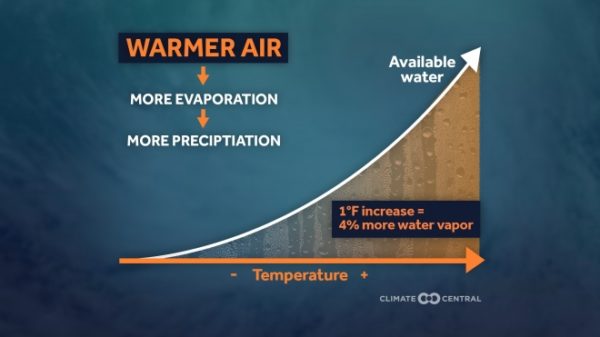![]() This Friday at noon, the Kent State University Department of Geology is hosting a panel discussion on the human role in the catastrophic flooding experienced by Houston and surrounding communities in the wake of Hurricane Harvey. I will be one of five faculty participating in the discussion. Since I know that many of you aren’t local, I thought I’d summarize my talking points below.
This Friday at noon, the Kent State University Department of Geology is hosting a panel discussion on the human role in the catastrophic flooding experienced by Houston and surrounding communities in the wake of Hurricane Harvey. I will be one of five faculty participating in the discussion. Since I know that many of you aren’t local, I thought I’d summarize my talking points below.

What’s the connection between climate change, hurricanes, and rain?
Established Physics: Warmer sea surface temperatures lead to more intense hurricanes. And the Caribbean and Gulf of Mexico are really warm right now. That’s also one of the reasons that Irma has been able to maintain its Category Five status for such an unprecedented length of time. You can read more about how hot waters fuel hurricanes in this NASA Earth Observatory post on Irma.

NASA Earth Observatory image of Irma’s path (as of September 6) and sea surface temperatures, September 3-5.
Simple Math: Sea level rise contributes to a higher storm surge. Storm surge wasn’t the problem in Houston, but it was a contributor the major damage that occurred in the coastal communities where Harvey made landfall and it’s a huge piece of the story in the devastating destruction that Irma is causing in the Caribbean right now. Of course, higher storm surges aren’t a problem if you have buildings higher relative to the sea level. But our buildings aren’t rising as fast as sea level, so higher sea levels and higher storm surges mean more storm surge damage.
Established Physics: Warmer atmospheres can hold more water, which leads to more big rains, which leads to more big floods. The physics of increasing saturation capacity with warmer air are taught to every meteorologist, via the Clasius-Claperyon equation. If you are not a meteorologist, Climate Central has a basic primer in the context of hurricanes. When that warm saturated air cools down, that’s when we get tremendous rains, because now the air isn’t warm enough to hang onto all that water vapor. In hurricanes, the cooling of the air (and rain generation) occurs simply because of warm air rising up into cooler parts of the atmosphere.

Climate Central’s graphic illustrating how warm air can hold more water and how that leads to more rain.
Possible: Climate change may lead to more rapid intensification of hurricanes. Harvey was one of the most rapidly intensifying hurricanes on record.
Possible: Climate change creates more ”stationary weather patterns” that hold weather in one place for days. The thing that really turned Harvey into an epic catastrophe for Houston was that it stayed in one place for days, rather than moving on to new places to drench. Michael Mann has a really nice explanation of how stationary weather patterns were in place during Harvey in this piece in the Guardian. Stationary weather patterns have also previously been blamed for terrible peat fires in Siberia and deadly heat waves in Europe, so they are not just a problem for hurricanes.
In my view, the science is incontrovertible, human-caused climate change contributed to the severity of Harvey’s impacts on Texas. I’m sure there are rapid attribution studies already kicking off that will be able to give us some sense of how much worse the wind and rain were as a result of our green house gas emissions.
Read on for Part 2: Did urbanization make the flooding in Houston worse?



Comments (1)
Links (1)-
Pingback: Hurricane Harvey and the Houston Flood: Did Humans Make it Worse? (Part 2: Urbanization) | Highly Allochthonous